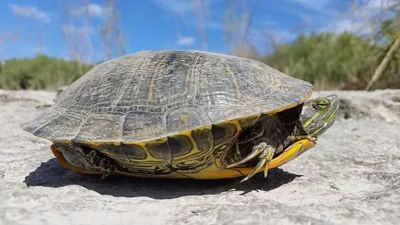Turtles, with their unique ability to navigate both aquatic and terrestrial environments, often evoke curiosity regarding their limitations outside of water. A central question arises: how long can a turtle be out of water?
The duration a turtle can spend out of water varies depending on several factors such as species, age, health, and environmental conditions. Generally, most aquatic turtles, including red-eared sliders and painted turtles, can tolerate being out of water for several hours, typically ranging from 4 to 12 hours.
However, prolonged periods out of water can cause stress and dehydration, potentially leading to health issues. It’s essential to provide access to water and a suitable habitat to ensure the well-being of pet turtles and to allow wild turtles to return to water promptly after terrestrial excursions.
How long can a turtle be out of water?

The duration a turtle can remain out of water varies based on several factors, including species, age, health, and environmental conditions. Here’s a breakdown of some key factors:
- Species: Different turtle species have evolved to adapt to varying environmental conditions. Aquatic turtles, such as red-eared sliders, painted turtles, and map turtles, are more tolerant of dry conditions compared to strictly terrestrial species like box turtles. Aquatic turtles have adaptations that allow them to retain moisture for longer periods.
- Age: Juvenile turtles generally have higher moisture requirements compared to adults. Young turtles may become dehydrated more quickly when out of water.
- Health: A turtle’s health plays a significant role in its ability to tolerate being out of water. Sick or injured turtles may have reduced tolerance and should be handled with care, minimizing the time they spend out of their aquatic habitat.
- Environmental Conditions: Factors such as temperature, humidity, and exposure to sunlight can affect a turtle’s ability to stay hydrated. Warmer temperatures and lower humidity levels can lead to quicker dehydration.
While there isn’t a fixed timeframe that applies to all turtles, as a general guideline:
- Aquatic turtles can typically tolerate being out of water for several hours to a couple of days, especially if they are kept in a humid environment.
- Terrestrial turtles, such as box turtles, may have more limited tolerance and should ideally have access to water or moist areas at all times.
It’s essential to monitor the turtle’s behavior and condition when it’s out of water. Signs of distress, such as lethargy, sunken eyes, or dry, flaky skin, indicate that the turtle needs to be returned to a suitable habitat promptly.
If you need to transport a turtle or handle it for any reason, minimize the time it spends out of water and provide a container with damp substrate or a damp towel to help maintain moisture levels. Always prioritize the turtle’s well-being and handle it with care.
Importance of water for turtles
Water is essential for turtles for several reasons:
- Hydration: Like all living organisms, turtles need water to survive. They rely on water for hydration to maintain bodily functions and prevent dehydration. Without access to water, turtles can quickly become dehydrated, leading to health issues and even death.
- Respiration: Many turtle species are aquatic or semi-aquatic, meaning they spend a significant portion of their lives in water. Aquatic turtles use water to facilitate respiration, as they have specialized respiratory systems that allow them to extract oxygen from water through gills or lung-like structures. Even terrestrial turtles need access to water for occasional soaking, which helps keep their skin moist and aids in respiration through skin absorption.
- Temperature Regulation: Water serves as a crucial element in thermoregulation for turtles. They often bask in sunlight on rocks or logs near water bodies to raise their body temperature. When they get too warm, they can retreat into the water to cool down. This behavior helps them maintain optimal body temperature, which is vital for their overall health and metabolic processes.
- Feeding and Hunting: Many turtle species are carnivorous or omnivorous and rely on water bodies for hunting and feeding. They hunt for prey such as fish, insects, crustaceans, and aquatic plants in water. Without access to water, turtles would struggle to find food and could face malnutrition.
- Reproduction: Water is crucial for the reproduction of aquatic turtles. They typically lay their eggs in nests on land near water bodies, and the hatchlings rely on water for survival after they emerge. Aquatic habitats provide a suitable environment for mating, egg laying, and hatchling development, ensuring the continuation of turtle populations.
- Habitat and Shelter: Water bodies serve as habitats and sources of shelter for turtles. They provide refuge from predators, nesting sites, and opportunities for social interaction. Healthy aquatic ecosystems with clean water are essential for maintaining viable turtle populations.
Overall, water is indispensable for turtles, playing vital roles in their survival, behavior, and ecological niche. Protecting aquatic habitats and ensuring access to clean water is crucial for the conservation of turtle species worldwide.
How turtles breathe underwater

Turtles have various adaptations that allow them to breathe underwater:
- Cloacal Respiration: Many species of turtles can absorb oxygen through specialized tissue in their cloaca, which is the posterior opening used for excretion and reproduction. This adaptation allows them to extract oxygen from water when submerged.
- Buccal Respiration: Some turtles, particularly aquatic species like softshell turtles and snapping turtles, can perform buccal respiration. They can pump water in and out of their mouths, allowing oxygen exchange to occur across the membranes lining their mouths and throats.
- Skin Respiration: While not as efficient as other methods, turtles can absorb small amounts of oxygen through their skin when submerged. This is more common in semi-aquatic and terrestrial species but may also contribute to their overall oxygen intake underwater.
- Gill Respiration (in some species): Certain turtle species, such as the Fitzroy River turtle (Rheodytes leukops), possess gills as hatchlings, which they lose as they mature. These gills allow them to extract oxygen from water similar to fish. However, this adaptation is relatively rare among turtles.
It’s important to note that while turtles have adaptations for extracting oxygen from water, they still need to surface periodically to breathe air. Most turtles are not capable of staying underwater for extended periods like fish; they must come to the surface to breathe.
The frequency at which they surface varies among species and individuals, but it typically occurs every few minutes to every few hours, depending on factors such as activity level, water temperature, and oxygen availability.
Factors Affecting Time Out of Water
The duration a turtle can remain out of water depends on several factors:
- Species: Different turtle species have varying degrees of adaptation to terrestrial life. Aquatic species like red-eared sliders and painted turtles are more tolerant of dry conditions compared to terrestrial species like box turtles. Aquatic species have evolved mechanisms to retain moisture for longer periods.
- Age: Juvenile turtles generally have higher moisture requirements compared to adults. Young turtles may become dehydrated more quickly when out of water.
- Health: A turtle’s health significantly affects its ability to tolerate being out of water. Sick or injured turtles may have reduced tolerance and can dehydrate more rapidly.
- Environmental Conditions: Factors such as temperature, humidity, and exposure to sunlight can influence a turtle’s ability to stay hydrated. Warmer temperatures and lower humidity levels can lead to quicker dehydration.
- Activity Level: Active turtles may lose moisture more rapidly than those at rest. Turtles that are moving around or exposed to sunlight may become dehydrated more quickly.
- Previous Hydration Levels: Turtles that are well-hydrated before being out of water can tolerate longer periods without access to water compared to those that are already dehydrated.
- Access to Moisture: Turtles can stay out of water longer if they have access to damp areas or moist substrates where they can rehydrate. Providing a humid environment can help slow down moisture loss.
- Size of the Turtle: Larger turtles generally have a higher body mass to surface area ratio, which may help them retain moisture for longer periods compared to smaller turtles.
- Behavioral Adaptations: Some turtle species have behavioral adaptations that allow them to conserve moisture. For example, some species may burrow into the ground or seek shade during hot, dry conditions to reduce water loss.
- Genetic Factors: There may be genetic variations within species that influence an individual turtle’s ability to tolerate being out of water.
Considering these factors, it’s essential to provide proper care and attention to turtles to ensure they have access to water and suitable environmental conditions to maintain their hydration and overall well-being.
Common Types of Turtles and Their Tolerance
Here are some common types of turtles and their general tolerance to being out of water:
- Red-eared Slider (Trachemys scripta elegans):
- Tolerance: Red-eared sliders are semi-aquatic turtles and can tolerate being out of water for moderate periods, especially if they are kept in a humid environment. However, they prefer aquatic habitats and should have access to water for swimming and basking.
- Painted Turtle (Chrysemys picta):
- Tolerance: Painted turtles are well-adapted to both aquatic and terrestrial environments. They can tolerate being out of water for moderate periods, especially if they have access to moist areas for rehydration. However, they are primarily aquatic and should have access to water for swimming and basking.
- Box Turtle (Terrapene spp.):
- Tolerance: Box turtles are terrestrial turtles that spend most of their time on land. They have limited tolerance for being out of water and should have access to shallow water for soaking and drinking. Box turtles can become dehydrated quickly if they are kept in dry conditions for extended periods.
- Snapping Turtle (Chelydra serpentina):
- Tolerance: Snapping turtles are primarily aquatic but can tolerate being out of water for short periods, especially if they are kept moist. They are capable of burrowing into mud or substrate to conserve moisture during dry conditions.
- Map Turtle (Graptemys spp.):
- Tolerance: Map turtles are semi-aquatic turtles that inhabit rivers and streams. They can tolerate being out of water for moderate periods, especially if they have access to moist areas for rehydration. However, they prefer aquatic habitats and should have access to water for swimming and basking.
- Musk Turtle (Sternotherus spp.):
- Tolerance: Musk turtles are semi-aquatic turtles that inhabit shallow, slow-moving waters. They have moderate tolerance for being out of water, but they prefer aquatic habitats and should have access to water for swimming and basking.
These are just a few examples, and the tolerance of individual turtles within each species can vary based on factors such as age, health, environmental conditions, and genetic factors. It’s important to provide proper care and attention to turtles to ensure they have access to suitable habitats and environmental conditions for their well-being.
How turtles survive drought conditions
Turtles have evolved several adaptations that help them survive drought conditions:
- Burrowing: Many turtle species are capable of burrowing into the ground when water sources dry up. They dig into the soil, creating a chamber where they can wait out dry periods until water returns.
- Estivation: Similar to hibernation, estivation is a state of dormancy turtles enter during prolonged periods of drought or extreme heat. They reduce their metabolic rate and become inactive, conserving energy until conditions improve.
- Shell Adaptations: Turtles have shells that provide protection from predators and environmental stressors. During droughts, they can retract into their shells to conserve moisture and reduce heat absorption.
- Water Conservation: Turtles are efficient at conserving water. They have specialized kidneys that can reabsorb water from their urine, minimizing water loss. Additionally, they may excrete uric acid instead of urea, which requires less water for excretion.
- Behavioral Adaptations: Turtles may alter their behavior during droughts to minimize water loss. They may become more nocturnal, seeking shelter during the hottest parts of the day when evaporation rates are highest. They may also migrate in search of remaining water sources.
Overall, turtles have evolved a combination of physiological, behavioral, and anatomical adaptations to survive drought conditions. However, prolonged or severe droughts can still pose significant challenges to their survival.
Risks of Prolonged Time Out of Water

Prolonged time out of water can pose several risks to turtles, especially aquatic species. Here are some potential risks:
- Dehydration: Turtles need water to stay hydrated. Prolonged exposure to dry conditions can lead to dehydration, which can have serious health consequences, including organ failure.
- Respiratory Problems: Aquatic turtles rely on water to breathe. Being out of water for too long can lead to respiratory problems, as they may struggle to get enough oxygen.
- Skin Problems: The skin of turtles can dry out and become irritated when exposed to air for extended periods. This can lead to infections or other skin problems.
- Thermal Stress: Turtles are ectothermic, meaning they rely on their environment to regulate their body temperature. Being out of water for too long can expose them to temperature extremes, leading to stress or even heat stroke or hypothermia.
- Muscle Weakness: Turtles are adapted to moving in water, and prolonged time out of water can lead to muscle weakness or atrophy. This can affect their ability to swim and hunt for food once they are back in their aquatic environment.
- Immune Suppression: Stress from being out of water can suppress the immune system of turtles, making them more susceptible to infections and diseases.
- Behavioral Changes: Turtles may become stressed or disoriented when removed from their natural habitat for too long, which can affect their behavior and overall well-being.
To mitigate these risks, it’s essential to ensure that turtles have access to appropriate aquatic environments with clean water, proper temperature, and adequate space. If a turtle is removed from water temporarily for cleaning or other purposes, it’s crucial to minimize the duration of the exposure and provide a suitable environment for them to return to quickly.
Conclusion
How long can a turtle be out of water? While it varies among species and individual circumstances, prolonged time out of water can pose significant risks to turtles. Dehydration, respiratory problems, skin issues, thermal stress, muscle weakness, immune suppression, and behavioral changes are among the concerns. To safeguard their health, minimize time out of water and ensure they have access to a suitable aquatic environment.

